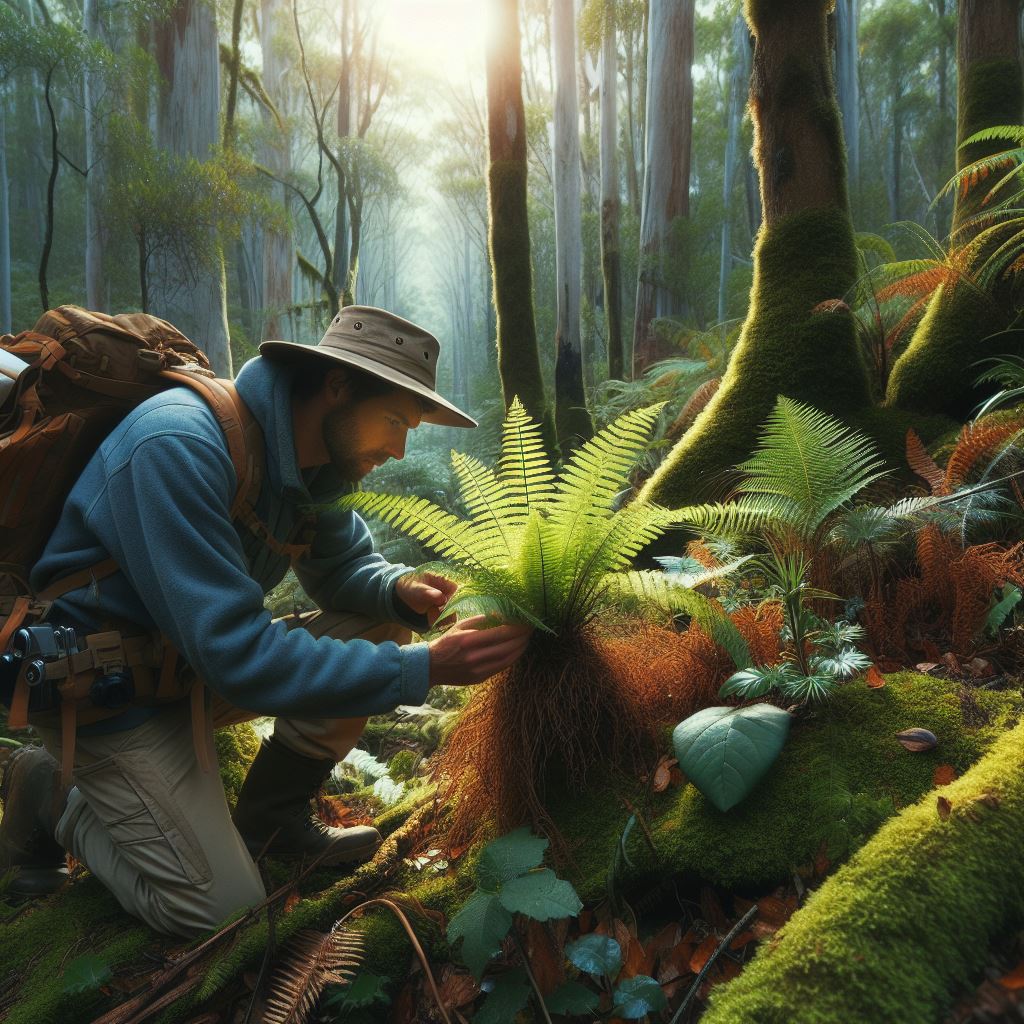Introduction
In this blog post, we will explore the topic of Australian Foresters and Indigenous Plants.
Indigenous plants play a vital role in Australia’s ecosystems, and it is important to understand their significance.
Foresters also have an essential role to play in preserving and promoting the use of Indigenous plants.
Indigenous plants are crucial for Australia’s ecosystems as they have adapted to the harsh climate and provide food and shelter for native wildlife.
These plants are an integral part of the delicate balance of the Australian environment, and their preservation is necessary for the overall health of the ecosystem.
Foresters, as stewards of the land, play a pivotal role in the preservation and promotion of Indigenous plants.
They work closely with Indigenous communities and traditional landowners to ensure sustainable management practices.
By incorporating Indigenous plants into reforestation efforts and land management plans, foresters contribute to the preservation of these vital species.
One of the main objectives of foresters is the restoration of degraded areas with Indigenous plants.
They understand the unique characteristics of these plants and their ability to thrive in specific environments.
By planting these native species, foresters enhance biodiversity and assist in restoring the natural balance of ecosystems.
Foresters also promote the use of Indigenous plants in various industries, such as timber production and landscaping.
By highlighting the benefits and value of these plants, foresters encourage the use of sustainable practices that support the growth and utilization of Indigenous species.
In general, Australian Foresters and Indigenous Plants are interconnected.
The protection and promotion of Indigenous plants by foresters are vital for the health and sustainability of Australia’s ecosystems.
By understanding their significance and working together, we can ensure the preservation of these unique species for future generations.
The significance of Indigenous plants in Australia
Indigenous plants hold immense significance in Australia, epitomizing the nation’s rich biodiversity and embodying the essence of its landscapes.
They have adapted to Australia’s unique climate and soil conditions, showcasing resilience and survival strategies honed over millennia.
The protection of these plants is paramount, not only for conserving biological diversity but also for safeguarding the ecological balance of fragile ecosystems.
Moreover, Indigenous plants carry profound cultural and historical significance for Aboriginal and Torres Strait Islander communities.
They are intertwined with traditional knowledge, serving as sources of food, medicine, and materials for cultural practices and ceremonies.
The deep connection between Indigenous peoples and these plants underscores their intrinsic value beyond ecological considerations.
By recognizing and preserving the diversity of Indigenous plants, we honor the heritage and wisdom of Australia’s First Nations peoples.
Moreover, fostering stewardship of these plants ensures the perpetuation of traditional ecological knowledge and supports Indigenous-led conservation efforts.
In essence, the significance of Indigenous plants in Australia transcends mere botanical diversity; it embodies a testament to resilience, cultural heritage, and the interconnectedness of humans and nature.
As custodians of this ancient land, it is our collective responsibility to cherish and protect these invaluable botanical treasures for generations to come.
Read: Soil Health and Its Importance in Aussie Farms
The Role of Foresters in Promoting Indigenous Plants
Forestry is the science and practice of managing forests and their resources, including trees, plants, and wildlife. It plays a crucial role in the conservation and sustainable use of Indigenous plants, which are integral to the biodiversity and cultural heritage of Australia.
Foresters work diligently to ensure the preservation and promotion of Indigenous plant species.
By actively engaging with Indigenous communities and traditional landowners, they facilitate a collaborative approach to managing and utilizing these valuable resources.
One of the primary objectives of foresters is to achieve a balance between resource extraction and ecological preservation.
They employ various strategies to conserve and sustainably use Indigenous plants, allowing future generations to benefit from their immense value.
Foresters take significant measures to protect Indigenous plant species from habitat destruction and invasive species.
They establish protected areas and implement strict conservation policies to prevent the loss of biodiversity and the erosion of Indigenous culture.
Specific initiatives taken by foresters to protect and promote Indigenous plant species
Moreover, foresters actively promote the use of Indigenous plants in ecological restoration and land rehabilitation projects.
They recognize the inherent resilience and suitability of these species in restoring disturbed ecosystems and reinstating their natural balance.
Foresters also collaborate with Indigenous communities to develop innovative initiatives that focus on the cultivation and commercialization of Indigenous plants.
By supporting sustainable industries centered around these species, they promote economic growth while protecting their cultural significance.
One such initiative is the establishment of plant nurseries dedicated to propagating and growing Indigenous plants.
These nurseries serve as essential resources, supplying seedlings and saplings for reforestation efforts and providing educational opportunities for future foresters and community members.
Foresters also engage in research and monitoring programs to better understand Indigenous plants’ ecological functions and their role in maintaining ecosystem health.
These studies aid in identifying threats and designing effective conservation strategies to safeguard Indigenous plants for future generations.
Furthermore, foresters engage in community awareness campaigns to highlight the ecological and cultural importance of Indigenous plants.
By organizing workshops, seminars, and community events, they educate the public about the value of these species and inspire them to actively participate in conservation efforts.
Foresters collaborate with government agencies, non-profit organizations, and academia to advance research and policy development related to Indigenous plant conservation.
By fostering multi-sector partnerships, they create a collective approach to address the challenges faced in protecting these invaluable resources.
In essence, foresters play a vital role in promoting the conservation and sustainable use of Indigenous plants.
Through their efforts in research, policy development, community engagement, and on-the-ground initiatives, they ensure that these plants thrive and contribute to Australia’s biodiversity and cultural heritage.
Read: Exploring Permaculture Practices in Australia
Indigenous plant species commonly used by foresters in Australia
Forestry practices in Australia often incorporate the use of Indigenous plant species due to their various characteristics and benefits. These plants serve multiple purposes ranging from timber production to medicinal properties and ecological functions.
Let’s delve deeper into some of the most commonly used Indigenous plant species in forestry practices and explore their significance.
- Eucalyptus: Eucalyptus is one of the most extensively used Indigenous plant species in Australia’s forestry sector. Known for its durable timber, it is utilized in construction, furniture production, and even paper manufacturing.
- Acacia: Acacia species, commonly referred to as wattles, are another group of Indigenous plants highly valued by foresters. These plants have strong wood suitable for making poles, fences, and even musical instruments.
- Callitris: Callitris, also known as cypress pine, is a genus of trees that provide high-quality timber used in various construction purposes. Its resistance to decay makes it an excellent choice for outdoor applications.
- Casuarina: Casuarina species, commonly called she-oaks, are widely utilized for their timber, which is commonly used in joinery, flooring, and fence construction. Additionally, they play a crucial ecological role in stabilizing dune systems.
- Allocasuarina: Similar to casuarina species, allocasuarina plants, known as she-oaks or bull-oaks, are valued for their high-quality timber. They are commonly used in furniture production and as support posts in vineyards.
- Melaleuca: Melaleuca species, commonly known as paperbarks, have unique properties, including resistance to termites and rotting. These qualities make them highly sought-after for timber used in outdoor applications like decking and fencing.
These Indigenous plant species bring several benefits apart from their timber production potential. They offer medicinal properties, provide ecological functions, and contribute to the overall sustainability of forestry practices.
Examples of how Indigenous plants are integrated into forestry management plans
In terms of medicine, Indigenous plants have been utilized for centuries by Aboriginal peoples and are now gaining recognition in mainstream healthcare.
For example, eucalyptus leaves contain essential oils that have antiseptic properties, commonly used in cough drops and decongestant balms.
Ecologically, these plants play a vital role in maintaining biodiversity and supporting native wildlife.
Acacia species, with their vibrant flowers and nectar production, attract bees and other pollinators, contributing to the health of ecosystems.
Additionally, the dense canopies of eucalyptus trees provide shelter to various native animal species.
Furthermore, Indigenous plants are integrated into forestry management plans to ensure sustainable forest practices.
For instance, reforestation efforts often focus on planting native species to rehabilitate degraded areas and restore the natural balance of ecosystems.
By prioritizing Indigenous plants, foresters promote the preservation of biodiversity and the cultural heritage of the land.
In a nutshell, the use of Indigenous plant species in Australian forestry practices is crucial for several reasons.
These plants provide valuable timber, possess medicinal properties, fulfill essential ecological functions, and contribute to the overall sustainability of forestry management plans.
Recognizing the significance of Indigenous plants supports the preservation of cultural heritage and the long-term ecological health of Australia’s forests.
Read: The Economics of Farming in Australia Unveiled

Challenges and opportunities
Challenges faced by foresters in preserving and utilizing Indigenous plants:
- Limited knowledge and understanding of Indigenous plant species and their ecological roles.
- Lack of expertise in identifying and managing Indigenous plants, leading to potential mismanagement.
- Limited access to resources and funding for research and conservation efforts related to Indigenous plants.
- Conflicts between conservation goals and economic interests, as Indigenous plants often compete with commercially valuable species.
- The threat of invasive species, which can outcompete Indigenous plants and disrupt ecosystems.
- Limited awareness and recognition of the cultural significance of Indigenous plants, leading to underestimation of their value.
- Legal and regulatory challenges in terms of land ownership and access rights for Indigenous communities.
Importance of education and awareness about Indigenous plants
- Enhances the understanding of Indigenous plant species and their ecological importance among foresters and the general public.
- Promotes sustainable management practices that prioritize the conservation and utilization of Indigenous plants.
- Encourages the integration of traditional ecological knowledge into forestry practices, benefiting both Indigenous communities and foresters.
- Raises awareness about the cultural significance of Indigenous plants, fostering respect for Indigenous traditions and values.
- Facilitates the development of innovative approaches for using Indigenous plants in various sectors, such as medicine, food, and cosmetics.
- Strengthens the collaboration between foresters, scientists, and Indigenous communities, leading to more effective plant.
Potential opportunities for collaboration between foresters and Indigenous communities
- Sharing traditional ecological knowledge and scientific expertise to enhance the understanding and management of Indigenous plants.
- Developing joint projects for research and conservation that involve Indigenous communities, promoting cultural and ecological sustainability.
- Establishing partnerships for the cultivation and sustainable harvest of Indigenous plants, promoting economic opportunities for Indigenous communities.
- Incorporating Indigenous plant species into forest restoration and reforestation projects, enhancing ecosystem resilience and biodiversity.
- Collaborating on educational programs and awareness campaigns to promote the value and conservation of Indigenous plants.
- Encouraging the inclusion of Indigenous representatives in decision-making processes related to land management and plant conservation.
- Recognizing and respecting Indigenous rights and traditional land practices while integrating them with forestry practices.
In fact, foresters face various challenges in preserving and utilizing Indigenous plants, including limited knowledge, conflicting interests, and legal barriers.
However, through education, awareness, and collaboration with Indigenous communities, these challenges can be addressed.
By recognizing the importance of Indigenous plants, sharing knowledge, and fostering partnerships, foresters can contribute to the conservation and sustainable use of these valuable plant species for the benefit of ecosystems and Indigenous communities.
Read: Indigenous Farming Techniques in Australia
Your Personalized Career Strategy
Unlock your potential with tailored career consulting. Get clear, actionable steps designed for your success. Start now!
Get StartedYou Might Also Like: Career Path: Becoming an Enviro Manager in AU
Learn More: Forestry Laws in Australia: A Quick Guide
Conclusion
In closing, Indigenous plants play a vital role in the preservation of Australia’s natural ecosystem.
Foresters contribute significantly to their conservation, ensuring their survival for future generations.
It is essential for readers to support and promote the use of Indigenous plants in various aspects of their lives.
By incorporating these plants into their gardens, landscapes, and daily routines, individuals can contribute to preserving the unique biodiversity of Australia.
To take action, I urge readers to learn more about Indigenous plants and the cultural significance they hold for Aboriginal communities.
By educating themselves and supporting initiatives that protect these plants, readers can make a difference in ensuring their long-term survival.
Let us all come together to celebrate the beauty and importance of Indigenous plants and work towards a harmonious coexistence with nature.
Together, we can preserve Australia’s natural heritage for generations to come.
So, go out and embrace the wonders of Indigenous plants in your life today!




